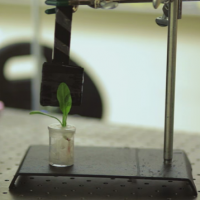Sensors and Spinach: When Plants Detect Bombs

Fitness trackers, cars, and refrigerators are embedded with sensors to inform us about our health, where we’re going, and maybe one day, let us know that we’re running out of milk. But what could embedded spinach leaves accomplish? For one thing, send an alert to the presence of explosives.
Sensors detect changes in the environment and then transmit that information back to a device. A new study from MIT reports that engineering electronic systems—in this case carbon nanotubes—into plants such as spinach can potentially detect harmful or dangerous chemicals found in landmines and explosives that are present in the groundwater sampled naturally by the plant. The information can then be wirelessly relayed to a handheld device, such as a smartphone. The scientists call the process “plant nanobionics.”
“Plants are very environmentally responsive,” says Michael Strano, the Carbon P. Dubbs Professor of Chemical Engineering at MIT and the research team leader. “They know that there is going to be a drought long before we do. They can detect small changes in the properties of soil and water potential. If we tap into those chemical signaling pathways, there is a wealth of information to access.”
Here’s how it works. According to the MIT website: When a particular chemical is present in the groundwater sampled naturally by the plant, carbon nanotubes embedded in the plant leaves emit a fluorescent signal that can be read with an infrared camera. The camera can be attached to a small computer (a Raspberry Pi), which then sends an email notification. Apparently if explosive molecules are contained in the groundwater, the time for the plant to draw the molecules up into the leaves where they are detected is approximately ten minutes. Spinach was used to demonstrate the versatility of the technique, but scientists say any living plant can be used.
Here’s a video demonstrating the plant-to-human communication. Naturally, your mother telling you to “eat your spinach, it’s good for you” does not apply here.

